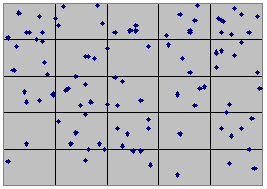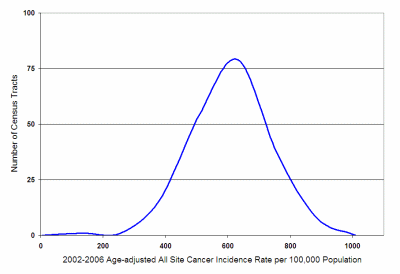About Cancer and Cancer Clusters
Cancer is not just one disease.
“Cancer” is a broad term that describes hundreds of different diseases, where there is uncontrolled growth and possible spread of abnormal cells throughout the body. As different types of cancers generally have different known and/or suspected risk factors associated with them, a common source is unlikely.
The exact cause of most cancers is unknown—many of the common cancers are associated with lifestyle factors.
Three of every five cancer deaths are due to tobacco use, being overweight, lack of physical activity, and poor nutrition. According to the National Cancer Institute these are the most common risk factors for cancer:
- Growing older
- Tobacco
- Excessive exposure to the sun
- Ionizing radiation
- Certain chemicals and other substances
- Some viruses and bacteria
- Certain hormones
- Family history of cancer
- Alcohol
- Poor diet, lack of physical activity, or obesity
Many of these risk factors can be avoided. Others, such as family history, cannot be avoided. Over time, several factors may act together to cause normal cells to become cancerous.
Environmental factors account for a small percentage of all cancer deaths.
A relatively small proportion of cancers are associated with exposure to toxic substances in the environment or workplace. Where toxic substances are known to be associated with particular cancers, the risk of developing cancer depends on both the level of exposure and the duration of exposure. In addition, individual people have different levels of susceptibility to cancer.
Cancer diagnosed today is usually related to events that happened many years ago.
When a cancer is due to contact with a known cancer-causing agent (for example mesothelioma and exposure to asbestos), the disease does not develop immediately. The lag time between possible exposure and development of cancer often makes it difficult to track the original cause, even if such a relationship could be established. For adults, there is often a long period (10 to 30 years or more) between the first exposure to a known cancer-causing agent and diagnosis of cancer associated with that threat.
Cancer clusters may occur by chance.
Even if there are more people with one type of cancer in a community than might be expected, it cannot be assumed the cancers of each individual were caused by exposure to a chemical in the environment. Some occurrences of increased (or decreased) rates of cancer are due to random variation. This is particularly true where small numbers of people are involved.

The figure above illustrates how cancer clusters can occur randomly. The 100 dots on this grid were randomly generated. In theory, there should be four dots in each of the 25 areas. But some have only one dot and others have many more than four. Think of the dots as cases of cancer, and the grid as Delaware.
For example, if the average number of brain cancers in an area is one per year, but in a given year there were two cases of brain cancer, the rate appears to have doubled. However it is extremely unlikely that there is a real doubling of risk in the community. In addition, when the numbers of cancer cases are small, it is very difficult for scientific studies to yield valid or useful information.

This figure shows that when cancer rates for each of Delaware’s 197 census tracts are calculated, they form a bell curve. Some are higher than the average for the state and some are lower.
Epidemiological Investigation
In order to determine whether the number of cases of cancer in a particular situation is higher than expected, epidemiologists use data from state and national databases to calculate an ‘expected’ number of cases. The expected number of cases is then compared to the observed number of cases by using statistical tests. It is usual to make statistical comparisons using a 95 percent confidence level. Within 95 percent confidence intervals, five out of 100 comparisons may be statistically significant by chance alone.
Cancer Clusters may occur for many reasons
In addition to chance, some areas have higher rates of cancer than others because of the following reasons:
- Better access to health care — If residents from one area may be more likely to be screened by their doctor for cancer compared to residents from another area.
- Grouping of lifestyle behaviors — Tobacco use, regular physical activity, diet, and other behaviors strongly impact cancer risk. If residents in one area are more likely to engage in unhealthy lifestyle behaviors, the cancer rate for that area may be elevated compared to other areas.
- Environmental or occupational exposure — For example, if residents in one part of a state are exposed to a harmful substance, either on-the-job or during their daily routines, they may have an increased cancer risk compared to residents in other areas who are not exposed to the same substance.
It is more likely that a cause of a cancer cluster will be found if a suspected cancer cluster involves:
- A large number of cases of one type of cancer, rather than several different types,
- A rare type of cancer rather than a common type,
- An increased number of cases of a certain type of cancer in an age group not usually affected by that type of cancer, or
- Significant exposure to a known carcinogen.
Usually, the causes of a cancer cluster cannot be determined.
It is difficult to conduct cancer cluster investigations in the community. Our environment is unstructured and constantly changing; our surroundings are influenced by regional, national, and global factors. In addition, there may be no records about the environmental factors from 30 years ago, when the seeds of cancer were sown. It is hard to know how much of the substance may be in the area and how long it has been there. It is also hard to know how long a person has been in contact with the substance.
Complicating the matter is the fact that people often move to different areas throughout their lives. Research from the U.S. Census Bureau indicates that from 2000-2004, Delaware had the seventh highest rate of in-migration (people moving into the state). Approximately 6 of every 1,000 Delawareans have recently moved here from another state. These high levels of in-migration make it difficult to know when and where a person’s exposure to a particular substance occurred.
|
Reasons Why Cancer Clusters are Difficult to Investigate:
|
For all of these reasons, the Division of Public Health has thought carefully about when it is appropriate to investigate a cancer cluster. We have published criteria for investigating cancer clusters and how they should be investigated based on the best scientific information available. The protocol, which was reviewed and approved by the Delaware Cancer Consortium, can be found here .
|
What Should You Do if You Suspect a Cancer Cluster? The Delaware Division of Public Health (DPH) has investigated many reported cancer clusters across the state. DPH approaches all requests for cluster investigations seriously. If you or your family members suspect a cancer cluster in your community or workplace, please call the Division of Public Health’s Cancer Program. Cancer Program staff will ask you several questions, including questions about the type or types of cancer, the number of cases of which you are aware, the community in which you suspect a cluster, and other information to help their investigation. |
To learn more about cancer cluster investigations that have been conducted by the Division of Public Health, visit our website at www.dhss.delaware.gov/dph/dpc/clusterinvestigations.html
For more information about cancer clusters, follow these links:
- Division of Public Health protocol for investigation of cancer clusters (PDF file)
- CDC page about cancer clusters
- Frequently Asked Questions (FAQs) from CDC
- Fact sheet on CDC role in investigating clusters
- Cancer cluster fact sheet from the National Cancer Institute
- American Cancer Society page on cancer clusters
![]() Please note: Some of the files available on this page are in Adobe PDF format which requires Adobe Acrobat Reader. A free copy of Adobe Acrobat Reader can be downloaded directly from Adobe . If you are using an assistive technology unable to read Adobe PDF, please either view the corresponding text only version (if available) or visit Adobe’s Accessibility Tools page.
Please note: Some of the files available on this page are in Adobe PDF format which requires Adobe Acrobat Reader. A free copy of Adobe Acrobat Reader can be downloaded directly from Adobe . If you are using an assistive technology unable to read Adobe PDF, please either view the corresponding text only version (if available) or visit Adobe’s Accessibility Tools page.



